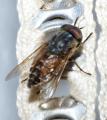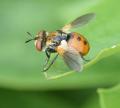Diptera.info :: Identification queries :: Diptera (adults)
Who is here? 1 guest(s)
|
Tachina magnicornis?
|
|
| Arp |
Posted on 30-07-2007 23:01
|
|
Member Location: Posts: 43 Joined: 06.10.06 |
Hi all, Here I am again asking yet another question about a very common fly that I can't seem to get my layman's head around. I encountered this Tachina (I suppose/hope) in the south-western France (Charantes Maritime - Cognac area) july 5th of this year. My general-purpose insect guides only list Tachina fera and for a moment I thought I'd found a name for the critter, but a subsequent internet search quickly destroyed that illusion and showed that it might very well also be T. magnicornis (or even some other?). The info I've found on distinguishing between these species is not very clear and various sources seem to have differing thoughts on the matter. What I've come up with so far is that the shape of he black dorsal band and he colour of the frontal tarsi could be tell-tale: T. fera: Band straightish, not forming clear "diamond" shapes and narrowing into a point toward the tale/5th segment. Tarsi yellowish. T. magnicornis: Band forming diamond shapes and ending wider on the 5th segment, not narrower. Tarsi brownish/dark. Looking at pictures here and elsewhere on the net that seems to be supported somewhat but not clearly. It also seems to me that he eyes of T. fera generally appear brighter and more reddish and those of T. magnicornis darker/brownish, but that's probably just my untrained eyes wanting to see differences  Anyway, based on that I would now probably choose magnicornis over fera but with "the internet" being he iffy source it is added to my nincompoop fly-recognition capabilities it wouldn't surprise me one bit if it turned out to be a bumblebee after all  As I figured it to be a real beginners issue I asked the same question with more possibly helpful images here on insektenfotos.de, but was kindly redirected to diptera.info as it seems to be not quite as trivial as I'd thought. So, can these species (or even others/more) be distinguished at all by merely looking at (my) pictures and if so, what should one look for (or: Is my internet summary somewhat accurate or total baloney?). Thanks in advance! Cheers, Arp Arp attached the following image:  [69.19Kb] |
|
|
|
| Arp |
Posted on 31-07-2007 12:47
|
|
Member Location: Posts: 43 Joined: 06.10.06 |
Okay, I've done some more homework ... and also searched this forum for "Tachina fera" now, not just "Tachina magnicornis". Only worked partly through that huge list though, but it's still not clear to me exactly what to look for ... below is my summary sofar ... Any tips on where to find definite info on he subject would be greatly appreciated!  Chris Raper states here that there are too many similar species in the south and that there is no comprehensive key for southern Europe. Also, here Theo warns about Portugal: "... they have praeceps as well, as some other species (casta). So take care!!". That's probably clear enough an answer regarding my "southernish" European fly, but at least the two species I considered above seem to be central European aswell and I know some of the folks on insektenfotos.de would also be interesred to know what to look for to tell these apart. Some of you (Theo, Paul, Chris, ...) seem to be able to do so in some cases (not all) with a fair amount of certainty by looking at an image. Susan R Walter here seems to have some literature and comes up with (compressed): T. magnicornis: Wider frons; Dorsal band widens on T5; Tarsi darker than tibia. Not completely unlike what I'd found before, but more reliable I guess, but her notes/remarks remain unanswered and hence unconfirmed. Then here Jorge Mota Almeida comes up with: T. fera: no proclinate orbitals, yellow tarsi, and the interval between the eyes is distinctly less than width of 1 eye (To which Theo later agrees). In this thread Jorge inquires why Theo determined his (other) fly as magnicornis, not fera and suggest "Due to the arista?", but Theo must have missed it. So, can the arista help in distinguishing the species? Other genera not to be confused: Eriothrix: This thread suggests that maybe Eriothrix rufomaculata could be confused with these Tachina. Gonia: This thread shows a Gonia vacua that is distinguished by "the very wide frons" (Chris) and Theo adds: "Not uncommon on the Balkan. Narrow black abdominal vitta and springtime are characteristic." Linnaemyia: Chris' answers in this thread and here suggests Linnaemyia might also have look-alikes? Quote: The mouth-edge is strongly projecting and the basicosta seems pale - could it be a Linnaemyia sp." Nowickia: This thread brings us Nowickia cf. ferox mixed in with T. fera and Theo explains: "the ones with black legs, esp. black tibiae, and a strongly contracted black vitta on the abdomen are Nowickia, most likely N. ferox. Tachina has the tibiae and part of tarsi reddish (with T. grossa the obvious exception)." Peleteria: As I've read here a clear foto of the (bristles in the) face would be good to distinguish between Tachina sp. and Peleteria sp.? Also, here Theo explains about P. rubescens: "strong bristles on the parafacialia ('wangen'  , which Tachina doesn't have.". And also here: "Strong bristles on parafacialia near lower eye margin are characteristic". , which Tachina doesn't have.". And also here: "Strong bristles on parafacialia near lower eye margin are characteristic".Miscelaneous: More Tachina vs. Peleteria vs. Nowickia here A very pale-coloured aberrant T. fera. Edited by Arp on 31-07-2007 12:51 |
|
|
|
| Susan R Walter |
Posted on 31-07-2007 13:06
|
|
Member Location: Touraine du Sud, central France Posts: 1799 Joined: 14.01.06 |
The literature I have is Chris Raper's translation of Peter Tschorsnig's key for Central European Tachnids, available via the Tachinid Recording Scheme website (run by Chris) http://tachinidae...nloads.php. I would say that you are not really likely to mix up E rufomaculata with Tachina, and once you have seen a few images or the real thing, probably not Gonia either. Nowickia and Peleteria are the ones to really be careful of, and I always forget how similar Peleteria especially is. If Theo and Chris can't ID a Tachnid from a photo, then it can't be done.  I think Theo only missed my thread because I timed it badly - the day he came home and had hundreds of desperate Tachinid enquiries waiting 
Edited by Susan R Walter on 31-07-2007 13:09 Susan |
| ChrisR |
Posted on 31-07-2007 13:23
|
|
Administrator Location: Reading, England Posts: 7699 Joined: 12.07.04 |
The fly in your photos is certainly a Tachina - a similar genus would be Peleteria but your photos don't show any "Peleteria bristles" on the lower part of the parafacial. Nowickia is also an alternative but the legs are jet-black (not brown, as in yours) and the dark patches tend to be very much blacker. In the UK it would be Tachina fera but to go further with your French specimen would require an expert familiar with the European fauna - and possibly a specimen. I have keyed a few T. magnicornis so if you want to send a specimen to me I'd be happy to key it through  |
| Zeegers |
Posted on 31-07-2007 17:08
|
|
Member Location: Soest, NL Posts: 18518 Joined: 21.07.04 |
as mentioned elsewhere, the shape of the band is quite unreliable. The colouration and density of hairs on jowls and parafacialia are better, as is the colouration and shape of the 3th antennal segment. All quite subtle. I will post some pictures to illustrate this, some time. Theo |
|
|
|
| Jump to Forum: |














